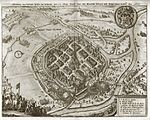Úhlava
Bohemian ForestCzech Republic river stubsPlzeň Region geography stubsRivers of the Plzeň RegionTributaries of the Berounka

The Úhlava (German: Angel) is a 104 kilometres (65 mi) long river in the Czech Republic, a right tributary of the Radbuza. Its source is situated on a slope of Pancíř mountain in the Šumava mountains, Klatovy District at an elevation of 1,214 metres (3,983 ft). It passes the villages and towns Nýrsko, Janovice, Bezděkov, Klatovy, Švihov, Lužany, and Přeštice before flowing into the river Radbuza at the south edge of Plzeň. Its major affluent is the Chodská Úhlava. The basin area of the Úhlava is 919 square kilometres (355 sq mi).
Excerpt from the Wikipedia article Úhlava (License: CC BY-SA 3.0, Authors, Images).Úhlava
Mlýnské nábřeží, Pilsen Doudlevce
Geographical coordinates (GPS) Address Nearby Places Show on map
Geographical coordinates (GPS)
| Latitude | Longitude |
|---|---|
| N 49.720555555556 ° | E 13.388611111111 ° |
Address
DiscGolf Slovany
Mlýnské nábřeží
305 40 Pilsen, Doudlevce
Southwest, Czechia
Open on Google Maps










